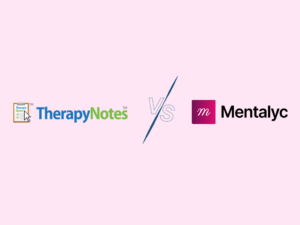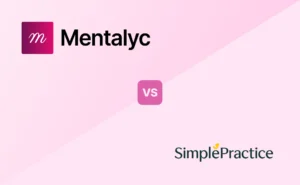In the American healthcare system’s ICD-10-CM coding (effective October 2024), F43.22 functions as a specific code for billing purposes. It signifies a diagnosis of Adjustment Disorder with Anxiety F43.21 also functions as a specific code for billing purposes. It signifies a diagnosis of Adjustment Disorder with Depressed Mood. Be aware that international versions of ICD-10 may utilize different codes for this diagnosis.
In this article, you’ll get an in-depth look at what adjustment disorders are, how the DSM-5-TR, and the ICD-10 codes you need to know. You’ll learn the differences between the types of adjustment disorders, the specifiers that provide more detail, and tips to ensure you select the most appropriate ICD-10 code. By the end, you’ll feel confident in your ability to code adjustment disorders and help your clients navigate life’s difficulties.
What Is an Adjustment Disorder According to the DSM-5-TR?
Experiencing a challenging life event can be overwhelming and cause significant mental distress. An adjustment disorder is a condition that can arise when someone struggles to cope with a situation, such as the loss of a loved one, a career change, or illness. The DSM-5-TR explains that symptoms typically appear within three months of the event and usually last no longer than six months after it has ended.
Facing an adjustment disorder can undoubtedly be a difficult journey. However, it’s essential to remind your clients that with proper diagnosis and treatment, many people can experience significant improvement in their symptoms and overall ability to handle stressful life events. With support and time, patients can develop more effective coping mechanisms and often recover fully.

New! Transfer your notes to EHR with a single click. No more copy-pasting.
The Different Types of Adjustment Disorders and Their ICD-10 Codes
It can be overwhelming to navigate the different adjustment disorders, each with its distinct ICD-10 code. However, determining the specific code that matches your client’s symptoms and presentation is crucial in providing the best care. This code can help identify any current complications and the maladaptive reaction type. Specifiers can also provide additional information about the adjustment disorder, such as whether it’s acute or chronic.
Always consider all these factors to understand your client’s unique situation. When choosing the correct ICD-10 code, focus on the individual’s primary symptoms and presentation. It’s vital to evaluate whether anxiety, depression, or both are the most prominent in hindering the person’s ability to cope or function normally. Remember, by taking the time to understand your client’s needs, you can provide them with the compassionate care they deserve.
- F43.20 Adjustment Disorder, Unspecified: When the specific stressor or symptoms are not specified.
- F43.21 Adjustment Disorder With Depressed Mood: When your client exhibits symptoms of depression, such as sadness, helplessness, hopelessness, low self-esteem, and worthlessness in response to a stressful life event.
- F43.22 Adjustment Disorder With Anxiety: Your client is experiencing excessive anxiety, including worry, restlessness, and panic attacks due to a stressful life event.
- F43.23 Adjustment Disorder With Mixed Anxiety and Depressed Mood: When your client experiences symptoms of depression and anxiety as a response to a stressful life event, use this code.
- F43.24 Adjustment Disorder With Disturbance of Conduct: This code pertains to situations where a person shows symptoms such as defiant behavior, aggression, and destruction of property as primary indicators. Your client may engage in antisocial or reckless behavior, such as violence, theft, or substance abuse, in response to a stressful life event.
- F43.25 Adjustment Disorder With Mixed Disturbance of Emotions and Conduct: When emotional distress and defiant behavior symptoms are present.
If you’re trying to figure out which adjustment disorder fits your clients’ experiences the most, you can ask yourself the following questions:
- Is the person mainly worried, restless, or irritable (anxiety)?
- Do they seem sad, hopeless, or pessimistic (depression)?
- Are symptoms of both anxiety and depression significantly interfering in their life?
Specifiers and Severity
It’s important to understand the condition of your clients, and that’s why accurately applying relevant specifiers and descriptors is crucial. This includes considering the severity of their condition, which can be classified as mild, moderate, or severe, depending on the level of distress and functional impairment.
For example, if your patient is dealing with anxiety, the F43.2x code is used, and for those experiencing a depressed mood, the appropriate code is F43.1x.If someone is experiencing a combination of anxiety and depressed mood, the F43.0 code should be used.
It’s also important to note any time-specific specifiers and consider the condition’s duration. If it lasts less than six months, it falls under the acute category, and you should use the .21, .11, or .01 code. If their symptoms have been present for six months or longer, it falls under the chronic category, and you should use the .22, .12, or .02 code.
FAQ: Common Questions About Adjustment Disorders and their ICD-10 Codes
Here are some of the most frequent questions we receive:
What exactly is an ICD-10 code?
ICD-10 codes are alphanumeric codes that classify diseases and health problems. These codes diagnose mental illnesses such as adjustment disorders, found in Chapter 5 (Mental, Behavioral, and Neurodevelopmental Disorders) of the ICD-10. They are used for clinical documentation, billing, and statistical purposes. These codes provide a common language for reporting diseases and conditions, making it easier to determine the medical necessity for treatment and what services insurance will cover.
What are the types of adjustment disorders and their ICD-10 codes?
The main types of adjustment disorders and their codes are:
- Adjustment Disorder with Depressed Mood (F43.21)
- Adjustment Disorder with Anxiety (F43.22)
- Adjustment Disorder with Mixed Anxiety and Depressed Mood (F43.23)
- Adjustment Disorder with Disturbance of Conduct (F43.24)
- Adjustment Disorder with Mixed Disturbance of Emotions and Conduct (F43.25)
- Unspecified Adjustment Disorder (F43.20)
What are the specifiers for adjustment disorder ICD-10 codes?
The specifiers provide more details about the adjustment disorder. Common specifiers include:
- Acute: Lasting less than six months
- Chronic: Lasting six months or longer
- Mild
- Moderate
- Severe
For example, F43.23 (Adjustment Disorder with Mixed Anxiety and Depressed Mood) may have the specifiers “acute, moderate.”
How do I ensure I use the right ICD-10 code?
To choose the correct ICD-10 code, you need to determine:
- The primary symptoms the patient is exhibiting (e.g., depressed mood, anxiety, disturbance of conduct)
- The severity of the symptoms (mild, moderate or severe)
- How long the symptoms have been present (less than six months = acute; 6+ months = chronic)
- Any other specifiers that apply (e.g., with suicidal thoughts)
- Double-check the code in the ICD-10 manual to ensure it’s accurate.
Accurately diagnosing and treating adjustment disorders is crucial for improving your clients’ well-being and quality of life. However, selecting appropriate ICD-10 codes and understanding the disorder can be complex. We recommend regularly referring to the DSM-5-TR and ICD-10 codebooks while conducting a comprehensive assessment to simplify the process. This involves determining the correct diagnosis applicable specifier(s), and selecting the ICD-10 code that best describes your patient’s condition. Armed with this knowledge, you can confidently assess and code adjustment disorders and help your patients who experience difficulties adjusting to a stressful life event start feeling like themselves again.
Mentalyc AI is an advanced tool that helps mental health professionals generate progress notes for psychotherapy sessions, saving time and energy. It is a valuable resource, and you can try our free trial today! By subscribing to our newsletter, you will stay informed about diagnoses, new technologies, and techniques to improve your clinical practice. Mentalyc AI also provides tips on note-taking, insurance audits, and HIPAA compliance. It is an excellent resource for students who want to join the mental health field and learn about career options.
Disclaimer
All examples of mental health documentation are fictional and for informational purposes only.
Why other mental health professionals love Mentalyc

“By the end of the day, usually by the end of the session, I have my documentation done. I have a thorough, comprehensive note … It’s just saving me hours every week.”
CDCII

“It’s so quick and easy to do notes now … I used to stay late two hours to finish my notes. Now it’s a breeze.”
Licensed Professional Counselor

“Having Mentalyc take away some of the work from me has allowed me to be more present when I’m in session with clients … it took a lot of pressure off.”
LPC

“It takes me less than 5 minutes to complete notes … it’s a huge time saver, a huge stress reliever.”
Licensed Marriage and Family Therapist






